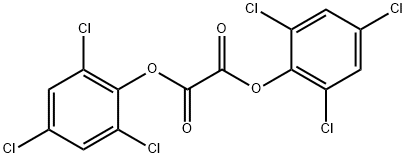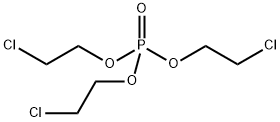Bis(2,4,6-trichlorophenyl)ethanedioate
Synonym(s):2,4,6-Trichlorophenyl oxalate;Oxalic acid bis(2,4,6-trichlorophenyl) ester;TCPO
- CAS NO.:1165-91-9
- Empirical Formula: C14H4Cl6O4
- Molecular Weight: 448.9
- MDL number: MFCD00043061
- SAFETY DATA SHEET (SDS)
- Update Date: 2024-10-31 13:32:20

What is Bis(2,4,6-trichlorophenyl)ethanedioate?
Chemical properties
WHITE CRYSTALLINE POWDER
The Uses of Bis(2,4,6-trichlorophenyl)ethanedioate
Bis(2,4,6-trichlorophenyl)ethanedioate is a chemiluminescent chemical that is often used as a fluorescent dye. Bis(2,4,6-Trichlorophenyl)Oxalate is often used in chemiluminescent assays, in types of ELISA and for the detection of various particles, structure or compounds.
The Uses of Bis(2,4,6-trichlorophenyl)ethanedioate
Reagent used for the generation of peroxy-oxalate chemiluminescence with H2O2. Used for the determination of fluorescent compounds in HPLC.
What are the applications of Application
Bis(2,4,6-trichlorophenyl) oxalate is a widely used reagent for the generation of chemiluminescence with hydrogen peroxide
Properties of Bis(2,4,6-trichlorophenyl)ethanedioate
| Melting point: | 188-192 °C |
| Boiling point: | 556.17°C (rough estimate) |
| Density | 1.698 |
| refractive index | 1.5550 (estimate) |
| Flash point: | 188-192°C |
| storage temp. | Sealed in dry,Room Temperature |
| solubility | almost transparency in hot Toluene |
| form | Crystalline Powder |
| color | White |
| BRN | 2312135 |
| CAS DataBase Reference | 1165-91-9(CAS DataBase Reference) |
Safety information for Bis(2,4,6-trichlorophenyl)ethanedioate
| Signal word | Warning |
| Pictogram(s) |
 Exclamation Mark Irritant GHS07 |
| GHS Hazard Statements |
H315:Skin corrosion/irritation H319:Serious eye damage/eye irritation H335:Specific target organ toxicity, single exposure;Respiratory tract irritation |
| Precautionary Statement Codes |
P261:Avoid breathing dust/fume/gas/mist/vapours/spray. P264:Wash hands thoroughly after handling. P264:Wash skin thouroughly after handling. P271:Use only outdoors or in a well-ventilated area. P280:Wear protective gloves/protective clothing/eye protection/face protection. P302+P352:IF ON SKIN: wash with plenty of soap and water. P305+P351+P338:IF IN EYES: Rinse cautiously with water for several minutes. Remove contact lenses, if present and easy to do. Continuerinsing. |
Computed Descriptors for Bis(2,4,6-trichlorophenyl)ethanedioate
New Products
4-Fluorophenylacetic acid 4-Methylphenylacetic acid N-Boc-D-alaninol N-BOC-D/L-ALANINOL Tert-butyl bis(2-chloroethyl)carbamate 3-Morpholino-1-(4-nitrophenyl)-5,6-dihydropyridin- 2(1H)-one Furan-2,5-Dicarboxylic Acid Tropic acid S-2-CHLORO PROPIONIC ACID ETHYL ISOCYANOACETATE 2-Bromo-1,3-Bis(Dimethylamino)Trimethinium Hexafluorophosphate (6-METHYL-[1,3]DITHIOLO[4,5-b]QUINOXALIN-2-ONE INDAZOLE-3-CARBOXYLIC ACID 4-IODO BENZOIC ACID (2-Hydroxyphenyl)acetonitrile 4-Bromopyrazole 5,6-Dimethoxyindanone 2-(Cyanocyclohexyl)acetic acid 4-methoxy-3,5-dinitropyridine 2-aminopropyl benzoate hydrochloride 1-(4-(aminomethyl)benzyl)urea hydrochloride diethyl 2-(2-((tertbutoxycarbonyl)amino) ethyl)malonate tert-butyl 4- (ureidomethyl)benzylcarbamate Ethyl-2-chloro((4-methoxyphenyl)hydrazono)acetateRelated products of tetrahydrofuran








You may like
-
 Bis(2,4,6-trichlorophenyl)ethanedioate 98% CAS 1165-91-9View Details
Bis(2,4,6-trichlorophenyl)ethanedioate 98% CAS 1165-91-9View Details
1165-91-9 -
 Bis(2,4,6-trichlorophenyl) oxalate, ≥99% (AT) CAS 1165-91-9View Details
Bis(2,4,6-trichlorophenyl) oxalate, ≥99% (AT) CAS 1165-91-9View Details
1165-91-9 -
 Bis(2,4,6-trichlorophenyl)oxalate 97.00% CAS 1165-91-9View Details
Bis(2,4,6-trichlorophenyl)oxalate 97.00% CAS 1165-91-9View Details
1165-91-9 -
![Bis(2,4,6-trichlorophenyl) Oxalate [Chemiluminescence reagent for the determination of fluorescent compounds] CAS 1165-91-9](https://img.chemicalbook.in//Content/image/CP5.jpg) Bis(2,4,6-trichlorophenyl) Oxalate [Chemiluminescence reagent for the determination of fluorescent compounds] CAS 1165-91-9View Details
Bis(2,4,6-trichlorophenyl) Oxalate [Chemiluminescence reagent for the determination of fluorescent compounds] CAS 1165-91-9View Details
1165-91-9 -
 Bis(2,4,6-trichlorophenyl) oxalate CAS 1165-91-9View Details
Bis(2,4,6-trichlorophenyl) oxalate CAS 1165-91-9View Details
1165-91-9 -
 1975-50-4 98%View Details
1975-50-4 98%View Details
1975-50-4 -
 14714-50-2 (2-Hydroxyphenyl)acetonitrile 98+View Details
14714-50-2 (2-Hydroxyphenyl)acetonitrile 98+View Details
14714-50-2 -
 118753-70-1 98+View Details
118753-70-1 98+View Details
118753-70-1
Statement: All products displayed on this website are only used for non medical purposes such as industrial applications or scientific research, and cannot be used for clinical diagnosis or treatment of humans or animals. They are not medicinal or edible.